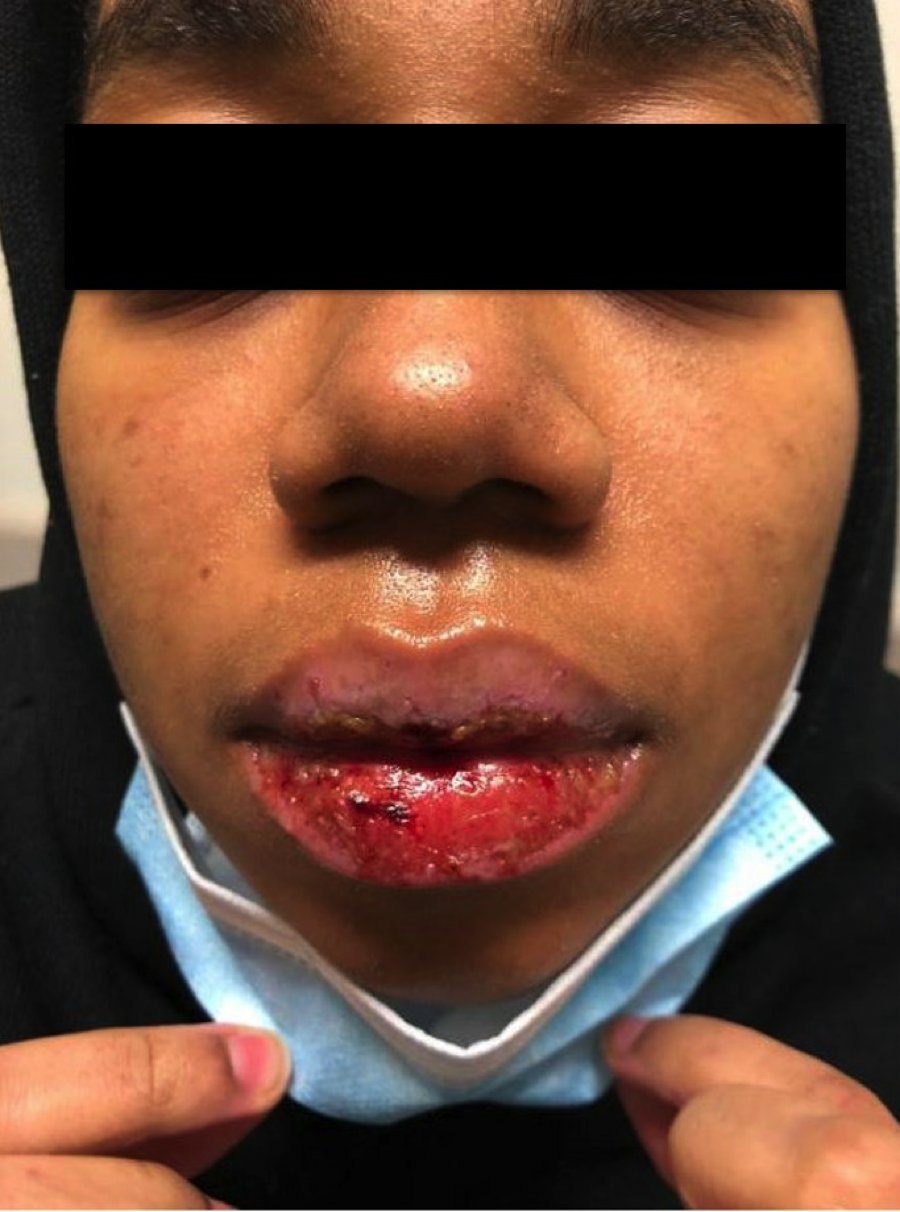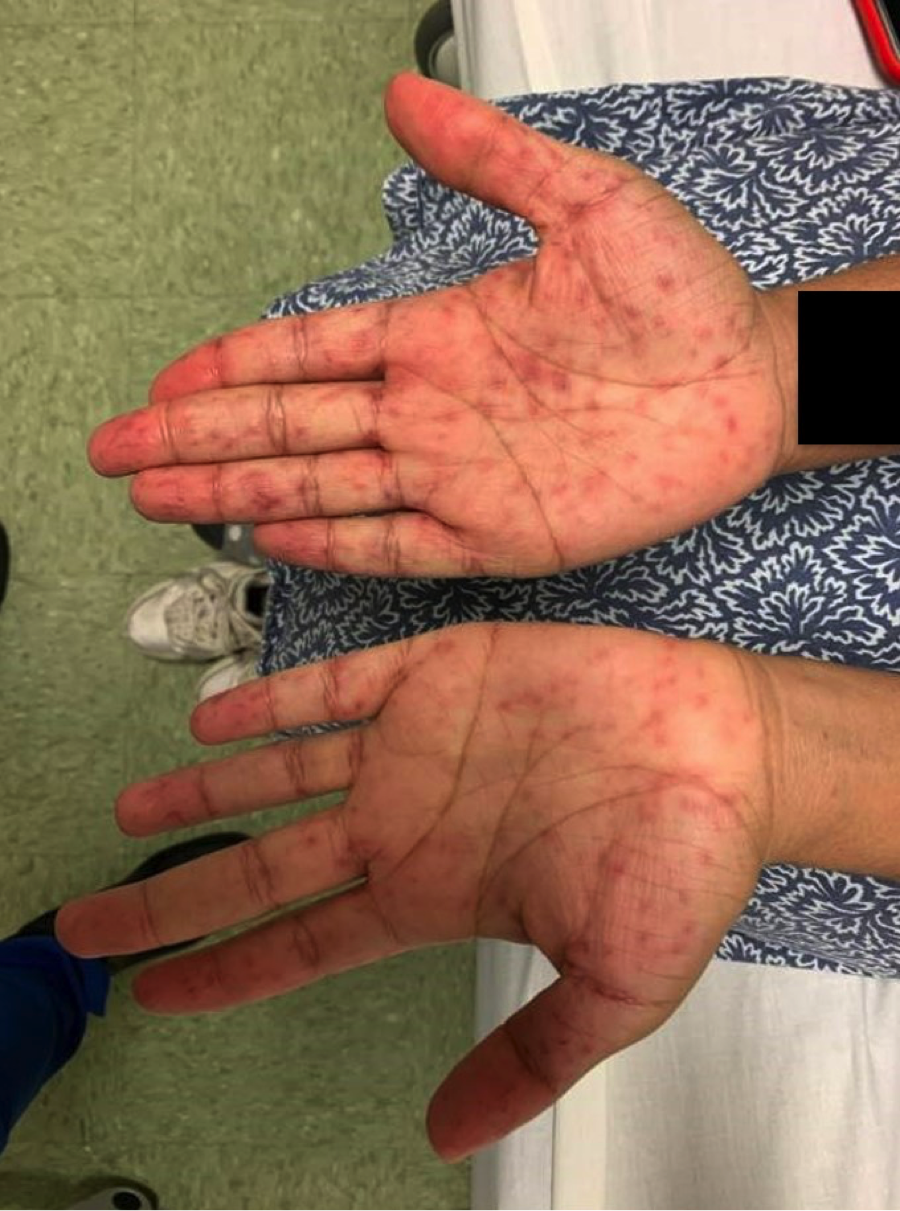Case Presentation: A 23-year-old female with a history of epilepsy presented to the emergency department (ED) for five days of tachycardia, oral ulcerations, and worsening palmar rash. She had presented to the ED three days prior with oral ulcers and dysphagia and was diagnosed with hand, foot, and mouth disease. On representation, her ulcers had worsened, and her lips developed sloughing, hemorrhagic blisters. She also reported a new painful ulcer on the labia minora. She denied respiratory or gastrointestinal symptoms, and had no fevers, dysuria, headache, or vision changes. Her medications included levetiracetam, lamotrigine, and topiramate for epilepsy, and she had recently started progesterone for irregular menses. She had no history of herpes. She denied sick contacts, recent travel, use of alcohol, recreational drugs, or tobacco. Her vital signs were normal apart from sinus tachycardia of 120 beats per minute. Eye exam significant for 1+ injection of the bilateral conjunctiva without purulent discharge. Skin exam revealed desquamative erosions on the lips and the hard and soft palette with crusted blood and scattered targetoid papules that involved both palms but spared the soles of her feet. Scattered tan, follicular-based macules were on her back, shoulders, and chest. Vaginal exam revealed a 1x1cm laceration on the right labia minora and a 0.5cm one on the left side.Laboratory testing included a normal CBC, BMP, and hepatic panel. Infectious work-up revealed negative results for HIV, COVID-19, syphilis, gonorrhea/chlamydia, blood and urine cultures. EBV IgM and IgG were both positive. HSV-1 IgG was negative, HSV-2 IgG and IgM were both positive, and HSV PCR and culture from an oral lesion was negative. Chest X-ray was negative for pneumonia.She was diagnosed with Mycoplasma-induced rash and mucositis (MIRM) which was treated with azithromycin, topical mupirocin and triamcinolone, and systemic steroids. At her follow-up visit eleven days after discharge, her lesions had largely resolved.
Discussion: The differential for this case is broad. The most likely alternate diagnoses include erythema multiforme major (EM) and Stevens-Johnson syndrome/toxic epidermal necrolysis (SJS/TEN). SJS/TEN is associated with medications and produces more systemic involvement of the skin along with fevers. EM can be caused by infections as well as drugs, although it usually only involves oral mucosa. Hand, foot, and mouth disease can cause oral ulcers, but does not tend to involve multiple areas. HSV or aphthous ulcers would not be associated with simultaneous blistering and desquamation of the lips and palm lesions. A palmar rash is seen in secondary syphilis, although this entity would not include multiple painful oral and genital lesions. MIRM characteristically involves at least two mucosal sites with skin desquamation of less than 10% of the body surface area, few vesiculobullous lesions, targetoid lesions, atypical pneumonia, and lab testing positive for mycoplasma or serial cold agglutinins.This patient also had IgM and IgG positive for HSV-2 suggesting recent infection with HSV-2. Because cultures of the lesions were negative for HSV, the lesions were attributed to MIRM rather than HSV-2.
Conclusions: MIRM is important to recognize as it can cause desquamation of mucous membranes, dysphagia and pain. However, it has a favorable prognosis. Observation, dermatology consultation, supportive therapy, and steroid treatment are necessary.


